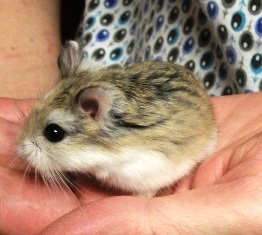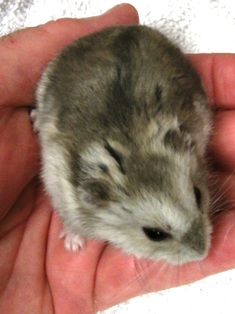Hamster Basic Info
Hamsters are very popular pets for children. There are five different species of hamsters available in the pet trade, the Syrian hamster and four species of dwarf hamsters. Each one has a slightly different personality and not all of them are great choices for children.
In fact, we recommend any time a small child handles a hamster, an adult should be present to ensure the child is being gentle and that appropriate hygiene is being practiced. Hamster cages should be placed in locations where young children cannot open the doors without assistance. It is best for older children or adults to take hamsters out of their cages since this is the time when hamsters are most prone to wiggle or nip.
Syrian Hamster
The most common pet hamster is the Syrian hamster (Mesocricetus auratus). This is also known as the golden hamster or common hamster. It has been selectively bred for many generations into a variety of colors and hair lengths. The Teddy Bear hamster has long fur which often requires brushing to stay unknotted. There are Black Bear hamsters which are solid black except for white feet, Panda Bear hamsters that are black with white patterns similar to the panda, albinos, leucistics, and many other kinds. Black Bear hamsters get larger than other breeds and as a rule are tamer and better around children. Any of the Syrian hamsters will become gentle pets for children when they are treated in a calm and gentle manner. Syrian hamsters may live 2 to 4 years, but most live 3 years or less.
The Syrian hamster is a solitary animal once it is about 2 months old. If you try to keep Syrian hamsters together after that age, they will usually start fighting. This fighting can be very harmful resulting in open wounds, missing feet, punctured eyes, and even death. It is best to keep the Syrian hamster by itself if you want a tame, healthy pet.

Roborovski Hamster (also known as Robo Hamster or Robo Dwarf Hamster)
A young adult "Robo hamster". These small speedsters do not sit still for petting, and are not the best choice for a small child who wants a cuddly pet.
The Roborovksi hamster (Phodopus roborovksi) is the smallest dwarf hamster available, generally weighing an ounce or less as an adult (30 g) and being about the size of a small chicken egg. A Robo hamster may live 2 to 3 years with some occasionally reaching 4 years. This hamster is fast and is definitely not a good choice as a handleable pet for small. Fortunately, it is much less prone to bite than other dwarf hamsters when it is handled. It is fascinating to watch one go about its business in a properly equipped large cage, especially one with lots of clear plastic tunnels, wheels, and other things to explore. Roborovksi hamsters are social and can be kept in small groups if they are raised together. However, if a new hamster is introduced to a group it may be bullied and fighting may erupt.
Robo hamsters may like chinchilla dust or chinchilla sand but they are not as likely to use it as Campbell's and Winter Whites. You can place a small bowl of this dust, available from pet stores, into the cage for 15 to 30 minutes. After a few explorations, many hamsters will learn to take a dust bath and groom themselves clean. This helps keep their fur fluffy and removes grease and oils.
Campbell's Dwarf Hamster
The Campbell's dwarf hamster (Phodopus campbelli) is closely related to the winter white hamster and can freely interbreed. In fact, many hamsters sold may actually be a hybrid of the two species. Campbell's dwarf hamsters live 18 to 30 months. They are often more outgoing and visible in their cages than other dwarf hamsters. With regular gentle handling, they become very good pets. As a general rule, Campell's dwarf hamsters are more prone to nip or bite when they are upset than the winter white. They are social and can live in groups but must be introduced to each other at an early age, typically no later than 8 weeks of age.
Campbell's dwarf hamsters seem to benefit from weekly access to chinchilla dust or chinchilla sand. You can place a small bowl of this dust, available from pet stores, into the cage for 15 to 30 minutes. After a few explorations, many hamsters will learn to take a dust bath and groom themselves clean. This helps keep their fur fluffy and removes grease and oils.
 Winter White Hamster (also known as Djungarian Hamster, Russian Dwarf Hamster, or Siberian Hamster)
Winter White Hamster (also known as Djungarian Hamster, Russian Dwarf Hamster, or Siberian Hamster)
A winter white hamster undergoing a color change.
Chinese Dwarf Hamster
Chinese dwarf hamsters (Cricetulus griseus) look like a cross between hamsters and mice. They have much longer bodies and longer tails than the other dwarf hamsters. Chinese dwarf hamsters are not truly hamsters since they come from a different genus of rodents than do the other hamsters. They are more timid than other hamsters and rarely bite, but they are as fast and unpredictable as the Roborovksi hamsters. A Chinese dwarf hamster will tend to wrap its small tail around part of your finger when it is sitting still on your hand. They typically live 2 to 3 years. They are not as social as other dwarf hamsters and generally do best as solitary pets or as a male and female pair that have been raised together since they were 8 weeks of age.



